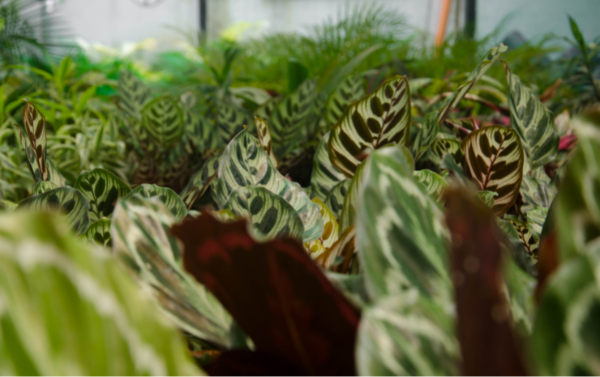==================
A Caveat and Affiliates
First off, a little caveat: within my articles you will find affiliate links, meaning if you buy them, I get a small commission. Your cost is not affected. In addition, I am an Amazon Associate and I earn from qualifying purchases on Amazon.
And yes, if I say that I recommend a product here, it means I truly believe it is a good product. I refuse to recommend any product that I have not researched and believe to be a good value.
Even better, I provide you with a very clear picture of the product, it’s use, and the probable value.
Earning your trust is important to me. I run this website myself and the commissions and donations help support the site.
Sound reasonable and fair enough? Let’s continue to the article.
==================
How to Grow Calatheas in Your Backyard?
Can growing calatheas in the backyard be successful, even if they are sensitive plants? Of course, you can. They will thrive in the backyard if you give them an environment favorable for their growth. There are several ways to plant them so you can enjoy their beautiful leaf patterns and benefits.
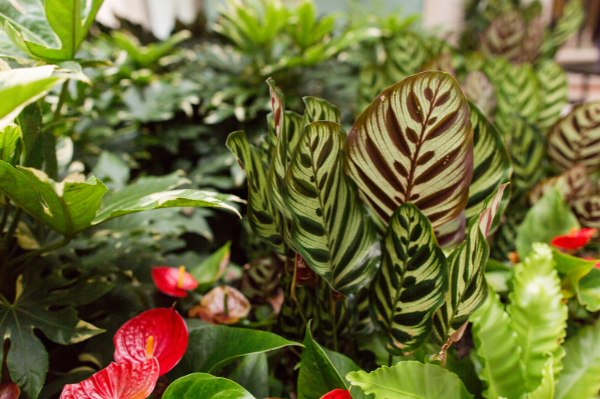
Since calatheas are tropical shrubs, you can have them all year round if you live in USDA Plant Hardiness Zone 8 or above. It includes the States of Florida, Georgia, Alabama, North and South Carolina, Texas, Arizona, California, Oregon, Washington, Arkansas, and more. So, you can grow calatheas in your backyard in these areas.
Stunning Calatheas to Grow in Your Backyard
Calatheas are gorgeous-looking evergreen perennials that have gained popularity among plant-enthusiasts. Many have fallen in love with their eye-catching leaf patterns. When calatheas have fully grown in your home and backyard garden, their stunning and decorative foliage beautifies and enhances these spaces.
Calathea Zebrina
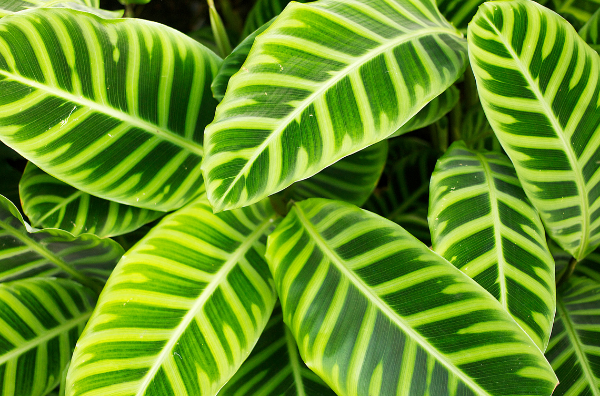
Calathea Zebrina has velvety smooth, lush foliage with attractive stripe patterns of different shades of green. That is how it gets its name, and the leaf patterns resemble a zebra’s coat, thus the name Zebrina. In addition, the leaf’s underside has a purple shade, contrasting the top side’s green color.
It is native to Brazil, so it tolerates bright indirect light. To bring the foliage to its best form, Zebrina needs a warm but humid atmosphere. So, you can grow it in your backyard as a row or gathering of taller bushes. Though this plant thrives in warmer climates, it still needs covering from the direct onslaught of sunlight.
Where to place these perennial foliage plants in your backyard? Calathea Zebrina loves to grow in pots inside your greenhouse. Also, other plants in the greenhouse provide moisture in the air to create a humid and warm environment. So, plant it outside the garden in a warm shaded spot with balanced light, not too little or too much.
Calathea Zebrina is a pet-safe plant, so it’s a bonus if you have fur babies playing in the yard. It also has an air-purifying property, removing toxic materials from the air. But it needs a lot of moisture; that is, moist but not wet. So, it loves the rain and grows large foliage and babies during the rainy season.
Also, it thrives in temperatures ranging from 65 to 75 degrees Fahrenheit. It can grow as tall as 3.28 feet or a bit higher. To avoid root rot, put it in a pot outside, and use easy-to-drain soil and large hole pots. Lastly, the root system is small and intricate where the rhizomes grow to develop into a new plant. Thus, it is so easy to propagate. And that’s another reason to try growing calatheas in the backyard.
Calathea Orbifolia
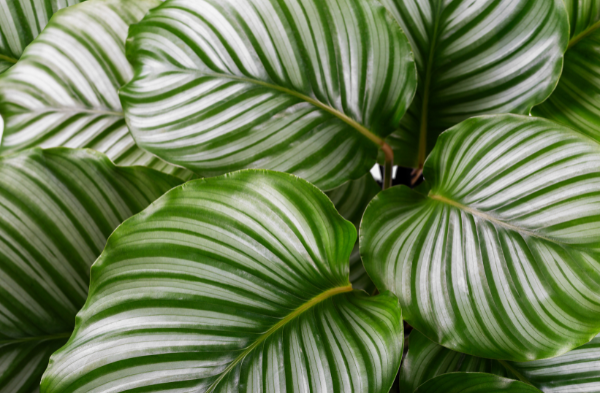
Calathea Orbifolia is a native to Bolivia. It has large, round green foliage with silvery stripes in the shades of green, with an underleaf of plain silvery green. Indeed an understated elegance, no doubt. What attracts plant-enthusiast is its round inverted-plate-shaped foliage with a little twist on some parts that makes a lovely addition to your backyard garden.
It grows well in medium-filtered light with regular watering to maintain moist soil but is not soggy. However, it needs high humidity to keep the foliage looking beautiful, with temperatures ranging from 65 to 75 degrees Fahrenheit. It doesn’t like repotting too often unless root bound, so plant them on shaded garden beds. But if you want them in a pot, use a well-draining potting mix.
This plant is pet-friendly and non-toxic to humans as well. It can grow to a 3 feet height and tolerates USDA Zones 9b-11. When the summer heat is high and the winter cold, you can bring it inside when potted. When planted on a garden bed, you can put some covers for protection from extreme weather.
Orbifolia generally is a slow grower, but the speed of growth depends on its condition. Plus, whether it meets its growing requirements. It becomes dormant during cool weather but perks up again when warmer temperatures come. Calatheas might be sensitive, but when you know how to take care of them properly, it gives you priceless beauty.
Calathea Dottie
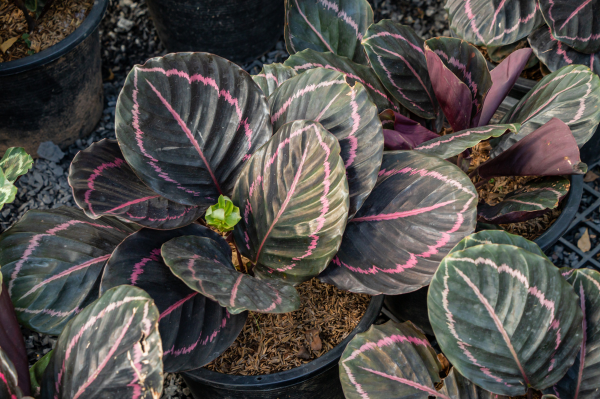
Calathea Dottie has a beautiful leaf pattern with deep dark purple foliage with pink patterns resembling a leaf. This plant is so stunning, but it can be a bit fussy. Like it can be sensitive to direct bright sunlight because of its color. As a result, the shade becomes lighter to the extent of developing a brown scorched portion on its leaf.
You can plant Dottie in your backyard on a spot where it can receive medium light. It may not be so sensitive after all. Still, it must have some protection from the sun. Therefore, the best location is in the greenhouse or shaded area with no direct bright sunlight. Like other calathea varieties, it must always be moist but not wet. Use rain or filtered water as the tap may be too harsh for this lovely Dottie.
Dottie is pet safe and grows well in pots with a well-draining soil mix. It can also be on raised garden beds to give them shade or cover them when the weather turns hot or cool. It is an excellent addition to your backyard with its color subtly contrasting the surrounding greenery.
Calathea Makoyana

Calathea Mokayana originates from Eastern Brazil. It grows to as high as 2 feet. The leaf grows straight up in a showy display of elegance and beauty just like the peacock’s tail. But the foliage is far from the color of the peacock. It is pale green with a dark green pattern that looks like a feathery effect that starts from the middle and ends at the outer edges. It has a dark pink underside which makes a great splash of contrasting colors.
Makoyana requires a balance of moisture and warmth. The ideal temperature for growth ranges from 60 to 75 degrees Fahrenheit. It is pet safe, so you can plant it anywhere in your backyard with no direct sunlight and moist soil. If exposed to direct rays of the sun, its beautiful foliage will burn and turn brown and dry.
When potted and placed in the backyard, it needs a potting mix that drains well, then you can propagate it once every two years. Beautiful makoyana multiplies through rhizomes just like other calathea varieties. You can separate the stems and ensure it has a root system to stabilize the new plant.
Calathea Medallion

Calathea Medallion is another variety of tropical plants and is also known as Calathea roseopicta. It has a large oval leaf with beautiful patterns in different shades of green and a purple underside. The beauty of the Calathea Medallion is in the splash of different shades of green that follows the shape of the leaf and the contrasting color of its underside.
Medallion thrives within the desired temperature of 65 – 80 degrees Fahrenheit with a humidity of at least 50%. It requires medium light away from direct sunlight or it will wither and burn its leaves. It can also thrive in low-light areas since the rainforest is its natural habitat with the canopy of tall trees and a humid environment.
You can plant Medallion in your backyard since it is pet safe and not-so-fussy plant. But keep it moist all the time but don’t get it soaked in water for far too long. Though it loves the rain and produces more babies during springtime, it doesn’t like soggy soil and winter frost. It becomes dormant when winter comes but will return to its glory during warmer weather.
To wrap it all up…

Calatheas are relatively easy to grow in the backyard. It takes a bit more effort to care for them. Yet, seeing their loveliness in your backyard is well worth the effort. If you give your tender loving care, you are rewarded with a stunning, blooming Calathea garden that everyone would love and admire.
When you give them the right growing conditions, they can thrive whole year round. They are easy to multiply and propagate through their rhizomes. So, when you get the hang of it, you’re on your way to mastering and growing calatheas in the backyard. It would be a fun, exciting, and fulfilling endeavor. You’d be rewarded with the joy of seeing them flourish with various colors and patterns.
READ MORE:
